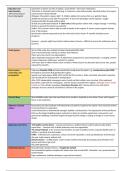Education and (Important as future security of regime, young minds = less future repression)
indoctrination 1)Portraits of Mussolini next to the king reassures conservative people, elevating status to be equal,
(Aim of focusing on came to power democratically
fascist ideologies) 2)Slogans ‘Mussolini is always right’ children idolise him and see him as a ‘god-like’ figure
3)Children learned to read with M’s speeches learn the ideologies and his opinions, taught
fundamental skills through political ideas
4)1928 one authorised textbook Libro Unico uniting Italian nation with a single message + rewriting
history to present the fascists as powerful.
5)after 1931, teachers had to take an oath of loyalty to the regime ensure youth supports fascists.
Only 1/100 refused
6)university students expected to join the University Fascist Youth benefits included career
prospects
However – parents might have tried to balance ideas at home + difficult to assess the enthusiasm from
teachers.
Youth groups Set up 1926 under the umbrella of Opera Nazionale Balilla ONB.
Girls received domestic training in cookery and childcare.
There were also church run organisations.
Opera Nazionale Dopolavaro OND adult lesiure programmes: sponsoring theatre, arranging summer
camps, Dopolavaro clubhouses, welfare for workers.
1939 more than 4 million Italians were members. Makes fascism an attractive ideal to buy into, people
enjoyed the benefits.
Press control, Took over Cinecitta 1938 and more fascist films made from this point, e.g., Luciano Serra, pilot 1938.
censorship, and Preceded by newsreels that glorified the regime.
propaganda Special rural radio agency (ERR) 1933 and led by PNF secretary. State controlled, Mussolini’s speeches
were broadcast live and played on loudspeakers.
After 1925 independent newspapers were closed and their editors were arrested. Only registered
journalists could write for newspapers, and the fascists controlled the register. Although wasn’t strictly
carried out, the catholic newspaper Ossevatore Romano didn’t always print in line with fascist
principles but was careful to avoid direct criticism of the regime.
Cult of il Duce Ideal infallible leader who had saved Italy from socialism, depicted as new Julius Caesar with imperial
Rome as his inspiration.
Influence of fascist Expected to join the Syndicate of Professionals and profess loyalty to the regime. Neo-classicists looked
culture to ancient Rome for inspiration.
Used architecture to demonstrate strength, stability, and dynamism. The Esposizione Universale Roma
EUR was the largest building project; extension to Rome to combine apartments, monuments, and
government buildings. Promoted regime through futuristic design, creating an image of a new Fascist
utopia.
Repression and Terror 1926 public security decree – anyone perceived as a political threat could be placed under police
supervision. – however only 9 death sentences were ever appointed.
The special tribunal, to try anyone who had been accused of political crimes, imposed 28,000 years of
jailtime + hundreds arrested weekly.
OVRA – infiltrated unis, businesses, unions, fearsome reputation. Could tap telephones and intercept
the post, hold suspects without trial.
Remote prisons – 10,000 people, south of Italy (confine) financially devastating, discrimination from
fascists and hard to get a job.
Kill 2,000 opponents
Antisemitic decrees Mussolini had a Jewish mistress – Margherita Sarfatti.
Not consistently applied, exception for Italian Jews that served WW1. Mussolini’s sons protected their
Jewish friends.
Pope condemned ‘unitalian attempt to copy German Nazism’




